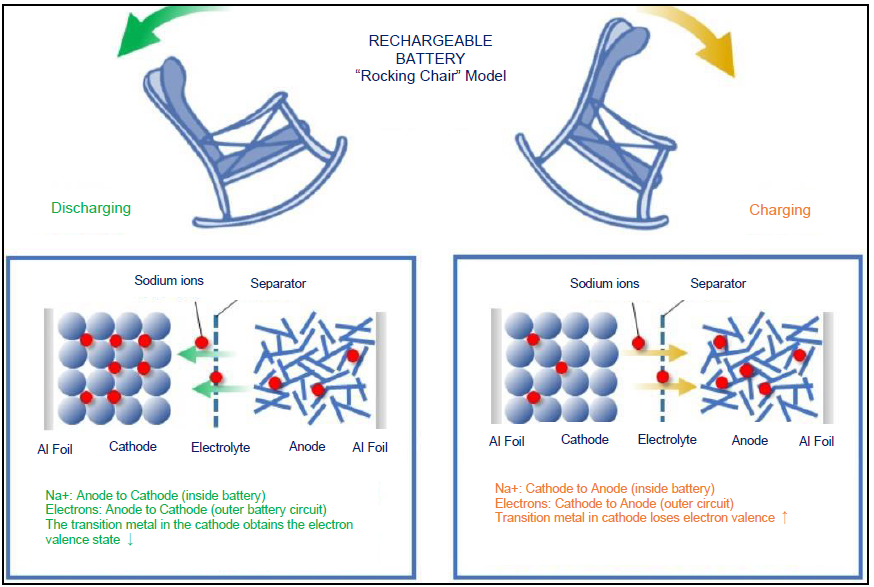Introduction
Sodium-ion battery technology is rising in popularity given its working principal is similar to that of the lithium-ion batteries. Sodium-ion batteries follow an intercalation-based “rocking chair” mechanism, whereby the embedding (intercalation) and stripping (deintercalation) process of sodium-ion between positive (cathode) and negative (anode) electrodes, which are parted by the separator soaked in electrolyte, realises charge and discharge.

Sodium-Battery Component Materials
In terms of the material system, except for the separator, all other base materials used in conventional sodium-ion batteries are different, especially the cathode material and anode material.
- Cathode: since sodium ions have a larger radius than lithium ions, it is difficult for them to intercalate making for poor energy density, therefore the cathode material types used today in sodium-ion batteries are namely layered transition metal oxides, polyanionic compounds or Prussian blue compounds.
- Anode: graphite-based anode material used in lithium-ion batteries cannot effectively intercalate sodium ions, therefore, the anode material used in sodium-ion batteries today is generally amorphous carbon-based material products such as hard carbon or soft carbon.
- Electrolyte: the molar conductivity of sodium ions is higher, which makes the concentration of electrolyte required for sodium-ion batteries lower, and the requirements for additives also lower. Today sodium hexafluorophosphate is used in sodium ion batteries.
- Separator: a sodium-ion battery uses polyethylene (“PE”) or polypropylene (“PP”) as its separator material, the same as lithium-ion batteries.
- Current collectors: both cathode and anode current collectors for sodium-ion batteries use aluminium foil. Whereas lithium-ion batteries use aluminium foil for cathode current collector and copper foil for anode current collector.
Cash Cost Analysis
Due to the difference in base material selection, the production cash cost between the two battery technologies varies greatly. Insiders state, if the NaCuFeMnO / soft carbon material system is used for sodium-ion batteries, when compared to a lithium iron phosphate / graphite material system used for lithium-ion batteries, the production cash cost savings of using sodium-ion batteries can be reduced by up to 30-40%.
Product Performance Comparison
- Sodium-ion batteries advantages include good safety, rate performance, and low temperature performance.
- Sodium-ion batteries disadvantages include poor cycle life and its energy density is comparable to only that of LFP batteries.

Principal Battery Production Method
Production of a sodium-ion battery is similar to that of lithium-ion battery, which mainly includes pole piece manufacturing (cathode, anode, stirring, slurry-drying-coating) and battery assembly (rolling-die-cutting-winding/stacking). The main difference is that sodium-ion batteries can use aluminium foil as the anode current collector, so the cathode and anode can use the same aluminium tabs and related processes such as tab welding.
The packaging form of sodium-ion batteries is similar to that of lithium-ion batteries, and can be divided into three categories: cylinder, soft package, and square hard case. On the whole, an existing lithium-ion battery assembly line can be used to produce sodium-ion batteries with a slight modification, and the replacement cost of developing a sodium-ion battery production line is very low.
Commercialisation
Sodium-ion batteries have comparable performance indicators when compared to lithium iron phosphate batteries as well as low production cost. Commercial applications include but not limited to large-scale energy storage systems, two-wheeler electric vehicles, and low-speed electric vehicles.
Of which, the large-scale energy storage industry consists of wind power plants, solar power plants and household energy storage systems. The low-speed electric vehicle industry consists of logistical vehicles, agricultural vehicles, electric vehicles, electric buses, and electric boats.
It is expected that sodium-ion batteries will complement and eventually replace lithium iron phosphate batteries in some fields in the future.

Competitive Landscape
The importance of sodium-ion batteries lies in their cost-effectiveness, sustainability, safety, performance, scalability, and wide range of applications. They represent a promising alternative to lithium-ion batteries, especially in the context of renewable energy storage.
After three decades of research and development, sodium-ion batteries are at the at the precipice of mass commercialisation. Commercialisation is accelerating with more than 20 companies investing in the sodium-ion battery industry. Chinese companies mainly include BYD, Zhongke Haina, Natrium Energy, and CATL, with more than 19GWh planned production capacity. Other companies include Faradion (UK), NAIADES (EU), Natron Energy (US), and Kishida Chemical, Toyota, Panasonic, and Mitsubishi from Japan.
Contact us to purchase the full report today
Click to view the Table of Contents

What is driving the growth of the sodium-ion battery technolog industry?
1. Cost and sustainability: sodium is the seventh most abundant element and is 1,200 times more common than lithium. This abundance ensures a sufficient, stable supply of raw materials.
2. Safety and performance: sodium-ion batteries have high safety, sustainability, and performance advantages over conventional lithium-ion batteries. They provide energy-efficient power with fast charging, stability against temperature extremes, and safety against overheating or thermal runaway.
3. Scalability: the technology of sodium-ion batteries is based around existing lithium-ion production methods, making it rapidly scalable. Essentially, this makes sodium-ion batteries important in meeting global demand for carbon-neutral energy storage solutions for countries around the world.
4. Applications: sodium-ion batteries are attractive prospects for energy storage applications where lifetime operational cost, not weight, is the overriding factor.
Further reading
Our comprehensive battery mineral research reports include a brief introduction, industry chain, product specifications, processing methods, raw material requirements, cash cost analysis, pricing metrics, future industry development trends, and the competitive landscape. If you have specific reseach topics, reach out by email and contact us today to learn more.
You might be interested in our other battery mineral research reports
For Further Information
